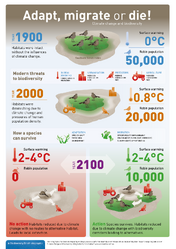
Evolution of the Peppered Moth-2

Fig. 1. Human harvest can have a variety of direct and indirect genetic effects on populations, and it has the potential to affect the future yield and viability of exploited populations.
Write the first paragraph of your page here.
Human-Induced Evolution[]
Palumbi (2001) noted that human impact on the global biosphere now controls many major facets of ecosystem functions.
Section heading
Due to the rise of technology, humans are able to accelerate the rate of natural selection among species through the industralization of agriculture, medicine and landscapes (Palumbi, 2001). When humans select phenotypically desirable animals from wild populations imposes selection that ca

n reduce the frequencies of those desirable phenotypes (Allendort and Jeffrey, 2009)
Thriving in the City . . .[]
An example of human-induced evolution can be found is species that have actually thrived in human dominated habitats like cities. Both racoons and coyotes are doing well despite that fact that their historic habitat has dwindled due to human activity.
Racoons were originally from the tropics but made their way north able to adapt to new environments along the way. Now they are found as far north as Alaska. Some scientists believe that as a species, racoons are getting smarter, probably due to moving into urban environments and having to problem solve to survive.
City raccoons are thriving, and some cities they are overrun with racoon populations such as Kassel, Germany which has the largest raccoon population in Europe, with up to 100 raccoons per square kilometer.
http://www.pbs.org/wnet/nature/lessons/raccoons-and-the-city/enhanced-video-resource/7942/
Allendorf, F. W., & Hard, J. J. (2009). Human-induced evolution caused by unnatural selection through harvest of wild animals. Proceedings of the National Academy of Sciences, 106(Supplement 1), 9987-9994. Palumbi, S. 2001. Humans as the World's Greatest Evolutionary Force. Science, New Series, 293: 5536, 1786-1